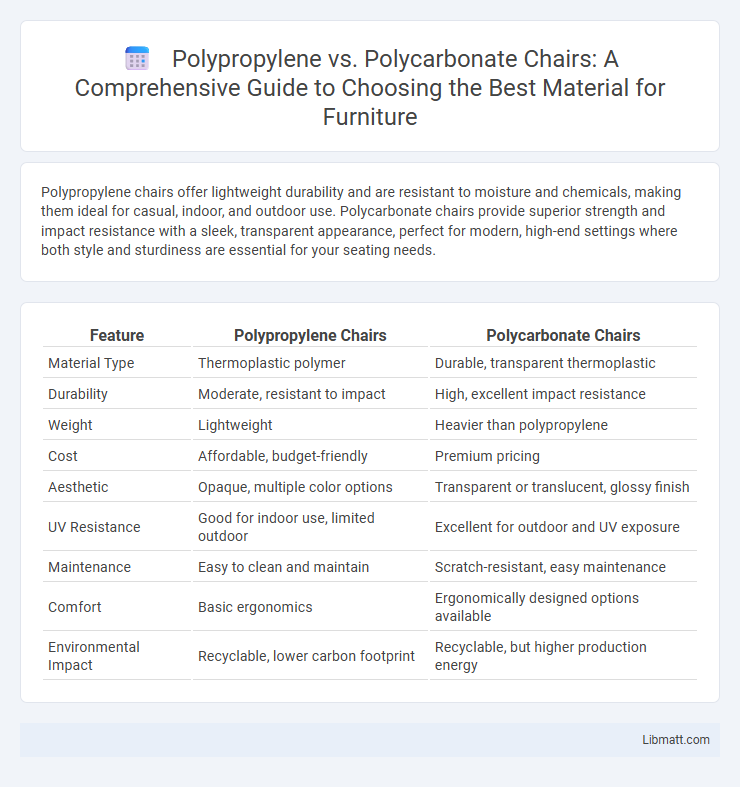Polypropylene chairs offer lightweight durability and are resistant to moisture and chemicals, making them ideal for casual, indoor, and outdoor use. Polycarbonate chairs provide superior strength and impact resistance with a sleek, transparent appearance, perfect for modern, high-end settings where both style and sturdiness are essential for your seating needs.
Table of Comparison
| Feature | Polypropylene Chairs | Polycarbonate Chairs |
|---|---|---|
| Material Type | Thermoplastic polymer | Durable, transparent thermoplastic |
| Durability | Moderate, resistant to impact | High, excellent impact resistance |
| Weight | Lightweight | Heavier than polypropylene |
| Cost | Affordable, budget-friendly | Premium pricing |
| Aesthetic | Opaque, multiple color options | Transparent or translucent, glossy finish |
| UV Resistance | Good for indoor use, limited outdoor | Excellent for outdoor and UV exposure |
| Maintenance | Easy to clean and maintain | Scratch-resistant, easy maintenance |
| Comfort | Basic ergonomics | Ergonomically designed options available |
| Environmental Impact | Recyclable, lower carbon footprint | Recyclable, but higher production energy |
Introduction to Polypropylene and Polycarbonate Chairs
Polypropylene chairs are lightweight, durable, and resistant to chemicals, making them ideal for both indoor and outdoor use with ease of maintenance. Polycarbonate chairs offer superior strength, impact resistance, and a sleek, transparent appearance suitable for modern aesthetics and heavy-duty applications. Your choice between these materials depends on balancing cost-effectiveness and durability requirements for specific environments.
Material Composition and Properties
Polypropylene chairs are made from a thermoplastic polymer known for its durability, flexibility, and resistance to chemicals and moisture. Polycarbonate chairs consist of a transparent or translucent polymer that offers high impact resistance, UV protection, and superior strength compared to polypropylene. The choice between polypropylene and polycarbonate chairs depends on factors like required toughness, appearance, and exposure to environmental elements.
Strength and Durability Comparison
Polycarbonate chairs exhibit superior strength and impact resistance compared to polypropylene, making them ideal for high-traffic or heavy-use environments. Polypropylene chairs offer good durability and flexibility but tend to be less resistant to cracking and UV degradation over time. In terms of longevity, polycarbonate materials maintain structural integrity under stress better than polypropylene, ensuring longer-lasting furniture solutions.
Weight and Portability Differences
Polypropylene chairs are significantly lighter, typically weighing between 2 to 4 pounds, enhancing portability for indoor and outdoor use. Polycarbonate chairs, though still relatively lightweight at around 5 to 8 pounds, provide greater durability but may feel bulkier to transport. The weight difference makes polypropylene ideal for stackable, easy-to-move seating, while polycarbonate offers sturdier options where mobility is less critical.
Comfort and Ergonomics
Polycarbonate chairs offer superior comfort and ergonomics due to their rigidity and ability to be molded into contoured shapes that support natural body posture. Polypropylene chairs, while lightweight and durable, often lack the ergonomic flexibility needed for prolonged seating as they tend to be firmer and less adaptive to body curves. When choosing your chair, consider polycarbonate for enhanced lumbar support and comfort during extended use.
Design Flexibility and Aesthetics
Polycarbonate chairs offer superior design flexibility with their ability to be molded into intricate shapes and maintain clear, glossy finishes that enhance modern aesthetics. Polypropylene chairs provide versatility through vibrant color options and lightweight, durable construction suited for both indoor and outdoor use. Your choice depends on whether you prioritize sleek, transparent elegance or bold, customizable styles for your seating needs.
UV and Weather Resistance
Polycarbonate chairs exhibit superior UV and weather resistance compared to polypropylene chairs, maintaining structural integrity and color stability under prolonged sun exposure. Polypropylene tends to degrade faster when exposed to harsh weather conditions, leading to brittleness and fading over time. For outdoor furniture applications where durability against UV rays and varying weather is critical, polycarbonate offers a more resilient choice.
Safety and Environmental Impact
Polypropylene chairs offer a non-toxic, recyclable option with low environmental impact due to their lightweight and energy-efficient production process. Polycarbonate chairs provide superior durability and impact resistance but involve more complex recycling and potential release of bisphenol A (BPA), raising safety and environmental concerns. Choosing polypropylene promotes sustainability and safer indoor air quality, while polycarbonate prioritizes strength but requires careful disposal to minimize ecological harm.
Cost and Value Considerations
Polypropylene chairs offer an affordable option with excellent durability and resistance to stains and impacts, making them ideal for budget-conscious users seeking practical value. Polycarbonate chairs, though more expensive, provide superior strength, transparency, and a sleek appearance, adding a premium look and longevity to your investment. Choosing between the two depends on balancing upfront cost with long-term performance and aesthetic preferences.
Ideal Use Cases and Recommendations
Polypropylene chairs excel in outdoor and casual indoor settings due to their lightweight, weather resistance, and affordability, making them ideal for patios, cafeterias, and event seating. Polycarbonate chairs offer superior durability, high impact resistance, and a sleek, modern aesthetic, perfect for office environments, high-traffic areas, or stylish home interiors. When choosing between the two, consider polypropylene for budget-friendly, versatile seating and polycarbonate for long-lasting, elegant solutions that withstand heavy use.
Polypropylene vs Polycarbonate Chairs Infographic

 libmatt.com
libmatt.com